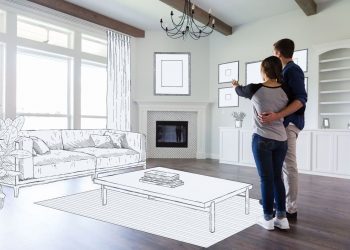Selecting a color scheme for your home can be an overwhelming undertaking. With so many color choices available, choosing the shade that will work best with the lighting and decor in your home can be a difficult task. However, by following a few guidelines, you can select a color scheme for your home that is cohesive and results in a visually soothing environment. Read on for tips on choosing a color scheme for your home.
60-30-10 Rule
The 60-30-10 rule is a decorating guideline that has stood the test of time. This means that 60% of a room should be a dominant color, 30% should be a secondary color and 10% should be an accent color.
Selecting Color for an Open Floor Plan
An open floor plan can feel challenging to select a color scheme since the area may feel like one large room. The whole space doesn’t have to be the same shade of paint, but the colors should flow together. Staying within the colors on the paint sample card is one way to ensure that the colors all have the same undertones, which is the best way to create a visually cohesive space. Bringing color to the trim and ceiling is another way to infuse additional color selections into a large space. If the open floor plan has shelving or bookcases, you can also paint or wallpaper the back to add different coordinating colors.
Determine the Feeling You Want the Home to Have
Knowing the color tones you gravitate to will help you establish a color direction. For example, if you prefer warm neutrals, select various shades of white, cream and greige. In addition, incorporate plenty of textures and elements that add dimension, such as wainscoting or other molding to give the space depth. Alternatively, if you crave bold, saturated colors, select a palette that is all jewel tones or all bright coastal colors to prevent it from feeling too overwhelming.
Test the Colors in Various Lighting
Once you’ve narrowed in on your ideal palette, test several variations of the colors on the wall and assess it during different times of the day. The color on the paint sample doesn’t always transfer to the wall, and the paint may also appear different in the morning sun than it does during the evening.
Create Contrast
To prevent all the rooms from looking the same, reverse the color order. For example, you may paint your entryway walls a pale color and the trim a darker color. Then, in the connecting living room, you can apply that dark trim color to the wall, with the pale color on the trim. This will create a different look that is also cohesive.
The ideal color palette for your home makes you feel the most relaxed at home and works best with your home’s lighting and design.











